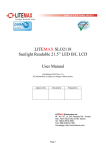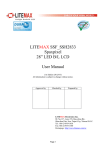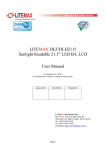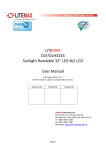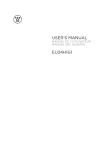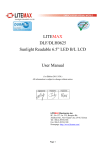Download LITEMAX SLG2325 Sunlight Readable 23” LED B/L LCD User Manual
Transcript
LITEMAX SLG2325 Sunlight Readable 23” LED B/L LCD User Manual (1st Edition 2014/Apr/14 ) All information is subject to change without notice. Approved by Checked by Prepared by LITEMAX Electronics Inc. 8F., No.137, Ln. 235, Baoqiao Rd., Xindian Dist., New Taipei City 23145, Taiwan Tel : 886-2-8919-1858 Fax: 886-2-8919-1300 Homepage: http://www.litemax.com Page 1 RECORD OF REVISION Version and Date Page Apr,14,2014 all Old Description New Description Initial Release Page 2 Remark Contents RECORD OF REVISION .................................................................................................. 2 Contents ............................................................................................................................ 3 1.0 GENERAL DESCRIPTION.......................................................................................... 4 2.0 Electrical characteristics ............................................................................................... 6 3.0 OPTICAL SPECIFICATION ..................................................................................... 16 4.0 AD6038GDP SPECIFICATIONS & OSD Functions .................................................... 19 5.0 MECHANICAL DRAWING....................................................................................... 30 6.0 PRECAUTIONS ......................................................................................................... 31 Page 3 1.0 GENERAL DESCRIPTION SLG2325 is 23” wide color TFT-LCD module as active switching devices with 1,000nits LED backlight powered by Durapixel™ technology. This module has a 23 inch diagonally measured active area with Full HD resolutions (1920 horizontal by 1080 vertical pixel array). Each pixel is divided into RED, GREEN, BLUE dots which are arranged in vertical stripe and this module can display 16.7M colors. FEATURES Sunlight Readable LED Backlight High Shock & Vibration Resistance Low Power Consumption High Uniformity Low EMI Noise Wide Dimming Life Expectancy Applications Gamming GENERAL SPECIFICATIONS Model No. SLG2325 Description Display Area (mm) Brightness Resolution Contrast Ratio Pixel Pitch (mm) Viewing Angle Display Colors Response Time (Typical) Sync Power Consumption Dimensions (mm) Weight (Net) 23" Wide TFT LCD, LED Backlight 1000 nits, FHD 509.18 (H) x 286.41(V) 1,000 cd/m2 1920 x 1080 (FHD) 1300 : 1 0.2652(H) x 0.2652(V) 178°(H), 178°(V) 16.7M colors 14 ms LVDS 42W 536.2(W) x 314.9(H) x 50(D)mm 5Kg SLG= Panel+LED Driving Board+Control Board+Housing Page 4 ABSOLUTE MAXIMUM RATINGS The following are maximum values which, if exceeded, may cause faulty operation or damage to the unit. ABSOLUTE RATINGS OF ENVIRONMENT Page 5 2.0 Electrical characteristics TFT LCD Module Power Specification Input power specifications are as following: Page 6 Page 7 Interface Connections LCD Module Page 8 Page 9 LVDS Input characteristics Page 10 Page 11 Signal Timing Specifications Page 12 Signal Timing Waveforms Page 13 Color Input Data Reference Page 14 Power Sequence VLCD Power Dip Condition Page 15 3.0 OPTICAL SPECIFICATION Item Contrast Ratio Luminance of White Response Time Uniform Symbol CRn LAVE Min. 800 τDRV 1000 Max. - Unit cd/m2 Note [1] [2] - 5 - ms [3] Lu 75 80 Rx - Red Ry Gx - Green Gy - Bx - Chromaticity Blue By Wx White Wy Viewing Angle x axis, right(φ=0°) x axis, left(φ=180°) y axis, up(φ=90°) y axis, down (φ=0°) - Typ. 0.6621 (± 0.03) 0.3308 (± 0.03) 0.3078 (± 0.03) 0.6114 (± 0.03) 0.1434 (± 0.03) 0.0674 (± 0.03) 0.3078 (± 0.03) 0.3456 (± 0.03) % - - - - - - - - - - - - - - - - θr - 89 - θl - 89 - θu - 89 - θd - 89 - Page 16 Degree - Test Mode: (1) Definition of Viewing Angle(θx,θy): (2) Definition of Test Point: A B C 1 2 3 Active Area Page 17 (3)BM-7 Measurement Setup: (4)Klein K-10 Measurement Setup: Page 18 4.0 AD6038GDP SPECIFICATIONS & OSD Functions We developed this A/D board to support industrial high brightness and commercial applications. This A/D board has many functions. It has a display port and DVI-I input. Rev.1 is European RoHS compliant. General Description Max Resolution Up To WUXGA+ Analog RGB Input up to 205MHz ULTRA-RELIABLE DVI-I INPUT Dual/single LVDS interface Support Panel DC5V or 12V Output OSD Control Inverter Analog or PWM Dimming Control. LED backlight driver on board. Input Power 12Vdc Display port input. (Support display port 1.1a) Page 19 Outline Dimensions AD6038GDP 210mmX60mm Page 20 AD6038GDP Board Pin Define CN5: Panel connector Pin No. Function Pin No. Function 1 RxO0- 16 RxE1+ 2 RxO0+ 17 RxE2- 3 RxO1- 18 RxE2+ 4 RxO1+ 19 RxEC- 5 RxO2- 20 RxEC+ 6 RxO2+ 21 RxE3- 7 RxOC- 22 RxE3+ 8 RxOC+ 23 GND 9 RxO3- 24 GND 10 RxO3+ 25 GND 11 GND 26 GND 12 GND 27 13 RxE0- 28 PANEL-VCC 14 RxE0+ 29 PANEL-VCC 15 RxE1- 30 PANEL-VCC NC CN2: DVI-1 INPUT Connector Pin No. Function Pin No. Function Pin No. Function 1 T.M.D.S. Data2- 9 T.M.D.S. Data1- 17 T.M.D.S. Data0- 2 T.M.D.S. Data2+ 10 T.M.D.S. Data1+ 18 T.M.D.S. Data0+ 3 T.M.D.S. Data2/4 Shield 11 T.M.D.S Data1/3 Shield 19 T.M.D.S. Data0/5 Shield 4 T.M.D.S. Data4- 12 T.M.D.S. Data3- 20 T.M.D.S. Data5- 5 T.M.D.S. Data4+ 13 T.M.D.S. Data3+ 21 T.M.D.S. Data5+ 6 DDC Clock 14 +5V Power 22 7 DDC Data 15 8 Vertical SYNC. 16 C1 Red input C4 Horizontal SYNC. Ground T.M.D.S. Clock Shield 23 T.M.D.S. Clock+ Hot Plug Detect 24 T.M.D.S. Clock- C2 Green input C3 C5 Analog GND (for +5V) Page 21 Blue input CN3: DISPLAY PORT Pin No. Function Pin No. Function 1 RX3- 11 GND 2 GND 12 RX0+ 3 RX3+ 13 GND 4 RX2- 14 GND 5 GND 15 AUX+ 6 RX2+ 16 GND 7 RX1- 17 AUX- 8 GND 18 Hot plug detect 9 RX1+ 19 GND 10 RX0- 20 DP +5V CN1: Power Jack (12V) Pin No. Function Pin No. Function 1 12VDC 2 12VDC 3 GND 4 GND J4: Touch Power connector Pin No. Function Pin No. Function 1 12V or 5V 2 GND Pin No. Function Pin No. Function 1 ON/OFF 2 J6: Control LID connector 3 Dimming GND CN6, CN7: Backlight LED (2PIN 2.0mm) Pin No. Function Pin No. Function 1 LED+ 2 LED- Page 22 J1: Key Pad (9PIN 2.0mm) Pin No. Function Pin No. Function 1 POWER KEY 6 MENU KEY 2 GREEN LED 7 AUTO KEY 3 RED LED 8 GND 4 DOWN KEY 9 GND 5 UP KEY JP1: Panel Power Pin No. Function Pin No. Function 1 12VDC 2 COMMON 3 5V CN4: RS232 Connector Pin No. Function Pin No. Function 1 5v 2 UART TX 3 UART RX 4 GND Page 23 MEMBRANE CONTROL BUTTOM POWER SWITCH: Pushing the power switch will turn the monitor on. Pushing it again to turn the monitor off. Power LED: Power ON-Green / Power off-No. Up Key >: Increase item number or value of the selected item. Menu Key: Enter to the OSD adjustment menu. It also used for go back to previous menu for sub-menu, and the change data don’t save to memory. Down Key <: Decrease item number or item value when OSD is on. OSD is off, it is hot key for input switch between VGA, AV, When and S-video. Screen Adjustment Operation Procedure 1. Entering the screen adjustment The setting switches are normally at stand-by. Push the Menu Key once to display the main menu of the screen adjustment. The adjustable items will be displayed in the main menu. 2. Entering the settings Use the Down Key < and Up Key > buttons to select the desired setting icon and push the SELECT button to enter sub-menu. 3. Change the settings After the sub-menu appears, use the Down Key < and Up Key > buttons to change the setting values. 4. Save After finishing the adjustment, push the SELECT button to memorize the setting. 5. Return & Exit the main menu Exit the screen adjustment; push the “MENU” button. When no operation is done around 30 sec (default OSD timeout), it goes back to the stand-by mode and no more switching is accepted except MENU to restart the setting. Page 24 OSD menu By pressing the “menu” button, you will see the below picture. Across from timing you will see resolution, frequency, and V-frequency of the panel. Version shows the firmware control version. These cannot be altered by the user. There are 7 sub menus within the OSD user interface: Brightness, Signal Select, Sound, Color, Image, Tools, and Exit. When you press the “menu” button, you enter the “Brightness” sub directory. In this directory, you will see 4 selections: press ’’right’’ key, you can go into the OSD Brightness. OSD Brightness: Press the “menu” once, to adjust the brightness. Press “left” to dim down the brightness to “0”, press “right” to increase the brightness to “100” Contrast: Press “menu” and “right” buttons to adjust the contrast from “0” to “100”. To adjust from “100” to “0”, press “menu” and the “left” buttons. Exit: back to the beginning menu. Page 25 Analog: RGB/VGA input Digital: DVI input DP: DisplayPort input Exit: back to the beginning menu. Auto Color:By navigating over to the “Auto Color” option, optimal color performance is invoked. SRGB: Windows standard color setting Page 26 Color Temperature: You have 4 options in this selection . Color Temperature User Define: Default is 100 for “R”, “G”, and “B”. Color Tempture_6500K: Warm color scheme Color Tempture_93OOK: Cold color scheme Exit: back to the beginning menu. Auto Adjust: Choose this option and the AD6038 will adjust to the optimal horizontal and vertical frequency. Clock: If you are not satisfied with the Auto tune result, you can adjust manually by pressing “Clock”. Using this will make the image wider. Page 27 Phase: If “double images” appear around the characters, choose “Phase” to remove them.. HPos: You can shift the screen horizontally using this function. Vpos: You can shift the screen vertically using this function. Exit: back to the beginning menu. OSD Control: Selecting this option, brings you to 5 more options: Osd_time: Select time for the OSD user interface to stay on screen, for 2 sec. to 16 sec. Default is 6 sec. Osd_HPos: Moves the OSD user interface horizontally on screen. Page 28 Osd_VPos: Moves the OSD user interface vertically on screen. Osd_Rotation: Rotates the OSD user interface Rotation(0°/90°/180°/270°) on screen. Exit: You can exit this sub menu back to the beginning Factory_Reset: By pressing this, the screen will revert to factory settings, and the previous settings will be deleted. Sharpness: Sharpen characters. Dos_mode/Gxf_mode: For some old programs which use 640x400 and 720x400 (DOS Mode and graphics mode), This option needs to be selected manually. Exit: back to the normal screen Page 29 5.0 MECHANICAL DRAWING SLG2325 Page 30 6.0 PRECAUTIONS HANDLING PRECAUTIONS (1) The module should be assembled into the system firmly by using every mounting hole. Be careful not to twist or bend the module. (2) While assembling or installing modules, it can only be in the clean area. The dust and oil may cause electrical short or damage the polarizer. (3) Use fingerstalls or soft gloves in order to keep display clean during the incoming inspection and assembly process. (4) Do not press or scratch the surface harder than a HB pencil lead on the panel because the polarizer is very soft and easily scratched. (5) If the surface of the polarizer is dirty, please clean it by some absorbent cotton or soft cloth. Do not use Ketone type materials (ex. Acetone), Ethyl alcohol, Toluene, Ethyl acid or Methyl chloride. It might permanently damage the polarizer due to chemical reaction. (6) Wipe off water droplets or oil immediately. Staining and discoloration may occur if they left on panel for a long time. (7) If the liquid crystal material leaks from the panel, it should be kept away from the eyes or mouth. In case of contacting with hands, legs or clothes, it must be washed away thoroughly with soap. (8) Protect the module from static electricity, it may cause damage to the C-MOS Gate Array IC. (9) Do not disassemble the module. (10) Do not pull or fold the lamp wire. (11) Pins of I/F connector should not be touched directly with bare hands. STORAGE PRECAUTIONS (1) High temperature or humidity may reduce the performance of module. Please store LCD module within the specified storage conditions. (2) It is dangerous that moisture come into or contacted the LCD module, because the moisture may damage LCD module when it is operating. (3) It may reduce the display quality if the ambient temperature is lower than 10 ºC. For example, the response time will become slowly, and the starting voltage of lamp will be higher than the room temperature. OPERATION PRECAUTIONS (1) Do not pull the I/F connector in or out while the module is operating. (2) Always follow the correct power on/off sequence when LCD module is connecting and operating. This can prevent the CMOS LSI chips from damage during latch-up. Page 31


































